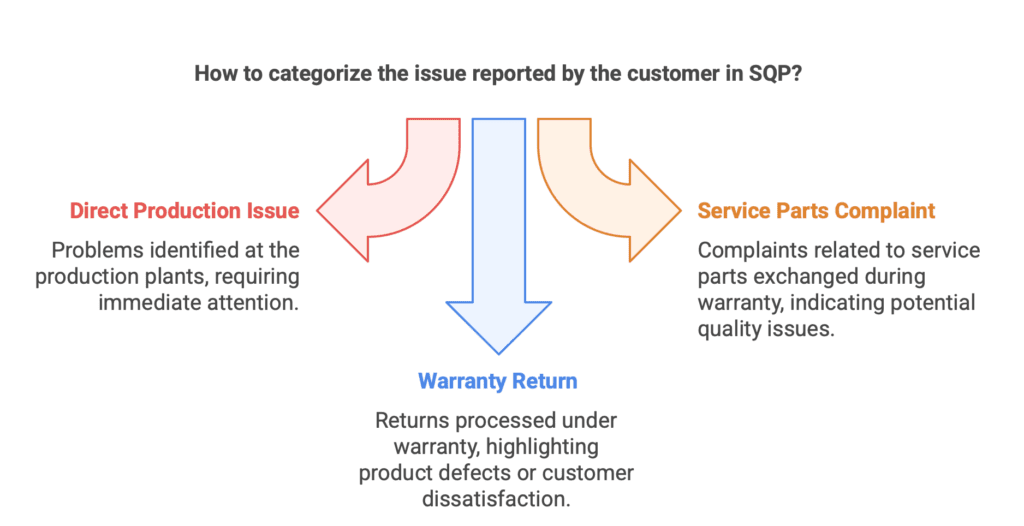Collaborating with the Stellantis xFCA client, we must be aware that quality and logistic complaints are managed through the SQP – Supply Quality Performance system. In this article, we present 3 effective strategies regarding the request for Dispute Request and the receipt of claimed parts.
Introduction to complaint handling in SQP
Customer complaints when working with this client divide into two categories. The first is the possibility of division into quality and logistic issues. The second concerns dividing based on the location where the customer identified the problem:
- 0-km. Issued directly by the customer’s production plants.
- complaints issued for service parts, which are exchanged by the customer in the warranty field,
- warranty returns.

The procedure 08018 and the manuals section directly on the SQP portal describe all scenarios. It is also worth familiarizing oneself with GSQN-001 – Global Stellantis Supplier Claim Management Procedure GSQN-001. Why? Because it describes the common guidelines for handling complaints throughout the Stellantis group.
How to manage a Dispute Request in SQP?
How does it work? We receive a complaint from the client with which we disagree. Then we prepare an 8D report in the SQP system. But only up to section D3.
If we believe that a particular quality issue was not generated by us, it’s advisable to invite a customer representative to participate in this analysis.
Why?
Because if we have him or her during the analysis, in the case of evaluating the “Dispute Request” by the person who issued the claim from that client facility, we will have a very constructive argument on our side. Of course, we are talking about jointly conducted verification with a client representative who guarantees that everything on the supplier’s side is fulfilled flawlessly.
This may result from verification conducted at the supplier’s location from component incoming area to verification in the shipping warehouse.
What if our facility is far from the customer’s facility?
Here I recommend two strategies. The first is remote assessment based on documentation sent to the customer’s SQE. As confirmation, I recommend an email from him or her, which we can add to the presentation attached. We have this option in the SQP system under Dispute Request section.
The second requires a bit more effort. In case our representative cannot come to us, I suggest coordinating the Dispute Request with another customer representative who will be conducting an audit at another supplier in our region at that time.
Remember about the proper timing of submitting the Dispute Request
When should you send it in SQP? In procedure 08018, point H19 states that we should do this within 10 business days. In practice, we have two weeks for this. This ensures that it will not be rejected for procedural reasons.
And why is this so important? Because after rejecting the “Dispute Request” application, the supplier is only allowed to complete the remaining sections of the 8D report. In practice, we cover all costs generated by the complaint even if this is not our fault.
Retrieve the claimed part from the customer’s scrap isolator
Another strategy, which is important when we receive a complaint, is to physically retrieve the claimed part. Photos of the claimed product are often attached to complaints in the SQP system.
In the hustle of daily tasks, we may forget to pick it up and conduct the analysis based solely on photographic documentation. Here, it is important to physically retrieve the claimed part. For what reason?
If we fail to do so, the customer may reject the 8D Report. Thus, the customer wants to tell the supplier: “We know you’ve already developed the 8D report, but we want space for more claimed parts.”
For this reason, the 8D Report will only be accepted when we pick it up.
These are three main strategies that I consider important to remember in cooperation with Stellantis xFCA. This will improve complaint management – which of course translates into a reduction in complaints (Dispute requests). Also, not insignificant is the impact on long-term relationship building with the customer – the retrieval on time of claimed parts from the scrap isolator.
If you want to learn more about working with this customer, I also warmly invite you to the training Stellantis xFCA CSR – Customer Specific Requirements management according to IATF.
Dariusz Kowalczyk


